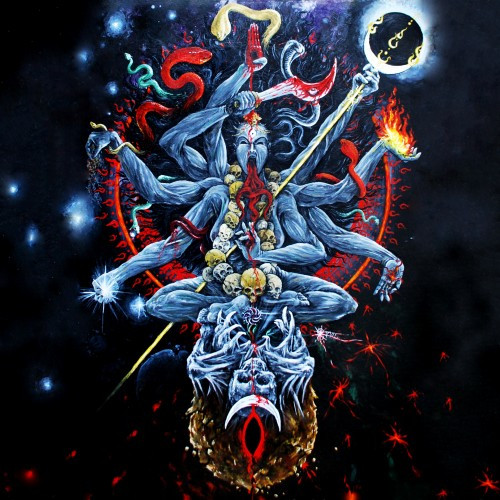Consider the idea of a Czech black metal band creating an album in homage to the Goddess Kali, the Aghoris, and Hindu funeral rites. With the album and song titles in Hindi. And they perform in embroidered robes and a striking array of strange hoods. Who wouldn’t be at least a little curious about the music? I certainly was.
मृत्यु का तापसी अनुध्यान (“Ascetic Meditation of Death”) is Cult of Fire’s second album, and is due for release on November 30 on the German label Iron Bonehead Productions. From the opening moments of the first track, it’s apparent that the band set their sights on creating something more complex and more artistically ambitious than a straightforward black metal blitzkrieg.
The music is in constant motion, transitioning between moods of light and dark, alternating the pace between hard-driving rhythms and stately progressions, crossing boundaries between incendiary assaults and gorgeous panoramas that more closely resemble post-rock than black metal. The melodies range from the bleak and heart-broken to the shimmering and soaring, but the overall atmosphere is one of epic grandeur, dramatic and impassioned.
Cult of Fire seamlessly incorporate layers of grinding guitars, rippling tremolo-picked melodies, head-grabbing rock riffs, eerie electronic sounds, the crackle of a wood fire, slow organ passages, sweeping synthesizer overlays, and even what sounds like the notes of a sitar in the hypnotic closing track. The drum work is equally varied and uniformly excellent.
There are hints of Indian melodies throughout the album, but they are much less prevalent than one might expect in light of the subjects that inspired the album. Where those concepts really come to life are in the vocals and the lyrics. Consistent with everything else about the album, the vocal styles are varied, but the dominant voice is something like a cross between a throat singer and the harsh ritualized chants of that Thuggee high priest in Indiana Jones and the Temple of Doom. In addition to those ugly incantations, there are also clean chants, impassioned howls, and in that final track, what sounds like the recital of some Sanskrit text.
 In their avant-garde leanings, Cult of Fire are reminiscent of Deathspell Omega. In their melding of blasting intensity and sublime guitar melodies, they are kindred spirits with Deafheaven. They can write compelling rock riffs and they know how to use electronic noise in a way that enhances the music. They write songs that move in surprising directions and that have staying power. And when you add to all of that the unusual array of chanted Hindu-inspired vocals, they don’t sound like anyone else. They work within the genre of black metal, but they are yet another excellent band who are sending it off toward new horizons. I’m utterly enthralled by what they have accomplished on this album whose name I can neither spell nor pronounce.
In their avant-garde leanings, Cult of Fire are reminiscent of Deathspell Omega. In their melding of blasting intensity and sublime guitar melodies, they are kindred spirits with Deafheaven. They can write compelling rock riffs and they know how to use electronic noise in a way that enhances the music. They write songs that move in surprising directions and that have staying power. And when you add to all of that the unusual array of chanted Hindu-inspired vocals, they don’t sound like anyone else. They work within the genre of black metal, but they are yet another excellent band who are sending it off toward new horizons. I’m utterly enthralled by what they have accomplished on this album whose name I can neither spell nor pronounce.
The album’s striking cover art was created by David Glomba (click the image at the top of this post to see a larger version of the cover). Below you can listen to “मृत्यु का वीभत्स नृत्य”, the album’s sixth track. According to Google Translate, the song title means “Ghastly Dance of Death”. I hope Iron Bonehead will start streaming one of the album’s more sweepingly melodic tracks (my vote would be for the 4th, the 7th, or the 8th song), to show how diverse the music is. You can also hear and download Cult of Fire’s first album, Triumvirát, on Bandcamp.
https://www.facebook.com/pages/Cult-Of-Fire/101579073262511



this sounds awesome, and i love the visuals. great stage costumes and the album artwork is pretty sweet
props for the Temple of Doom reference.
http://www.youtube.com/watch?v=WdJzhnbbT9c
This records is a killer, musically and visually!!!!!!!